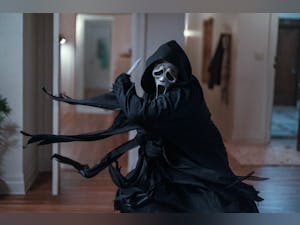From: Silver Screen
“The Dinner” is too long and complicated to enjoy
“The Dinner” tells the tale of two couples who meet over dinner to discuss what to do about their sons who are cousins and commit a serious crime. The conversation deepens and more information is shown and discussed as each new dinner course arrives. While the plot is an interesting idea, “The Dinner” ultimately loses the viewer and fails to entertain.
This mystery/drama is shown through the perspective of Paul Lohman (played by Steve Coogan), who is a mentally-ill retired history teacher. The film never discusses what is exactly he is suffering from, but alludes that he might have issues related to a mood or personality disorder. Unfortunately, it’s difficult to feel any emotional connection to him because he is so narcissistic in a situation surrounding his son and nephew.
The other main characters are equally underdeveloped. There is little to no background information given about any of the characters. Paul’s wife, Claire Lohman (played by Laura Linney), is patient with her husband in an almost obsessive way. Worse, she protects her son’s actions to an extreme that comes off as creepy. The film briefly touches on how Sarah’s battle with cancer in the past affected her relationship with her husband, but this background is barely developed in the film.
Paul’s brother, Stan Lohman (played by Richard Gere) plays the cliche role of a politician obsessed with his job and spends little time with his family. He also was the favorite child growing up, which Paul holds against him and is one of the few ways that the viewer can sympathize with the main character; but in the end it turns out Stan is one of the only likeable characters. His wife Katelyn Lohman (played by Rebecca Hall) is the least developed character, which is unfortunate because her fiery presence was engaging and in many scenes, rerooted the viewer in the plot of the film.
The plot follows an incredibly predictable pattern where one character will reference a memory, and then the viewer is shown the memory in the next scene through Paul’s point of view. While this tactic can sometimes provide an easy transition, in this case it acted as one of the two only ways the viewer was given any information or context about what was going on. This cliche style begins to get annoying halfway through the film, yet continues the whole way through. Even worse, the film often layers footage on top of other recolored footage so that multiple images are on screen at the same time in varied opacity, while different layers of sound coming fade in and out of these sequences. Though this may have been an artistic style choice in order to enunciate Paul’s mental illness, it is instead confusing to the point of being irritating.
One of the few bright spots of this film is during the scenes where the group is served their next course. The head waiter is endearingly charming as he describes what states each vegetable or cheese is from on everyone’s plates. His pleasant demeanor is well balanced with Paul’s remarks about how the food is too expensive, and provides some brief comic relief from the rest of the film.
Overall, “The Dinner” is too long and too complicated to enjoy. Each character could do with a lot more development, but the time it would take to do that would be too long to bear, considering the bizarre layering of footage and sound.
Grade: C-




